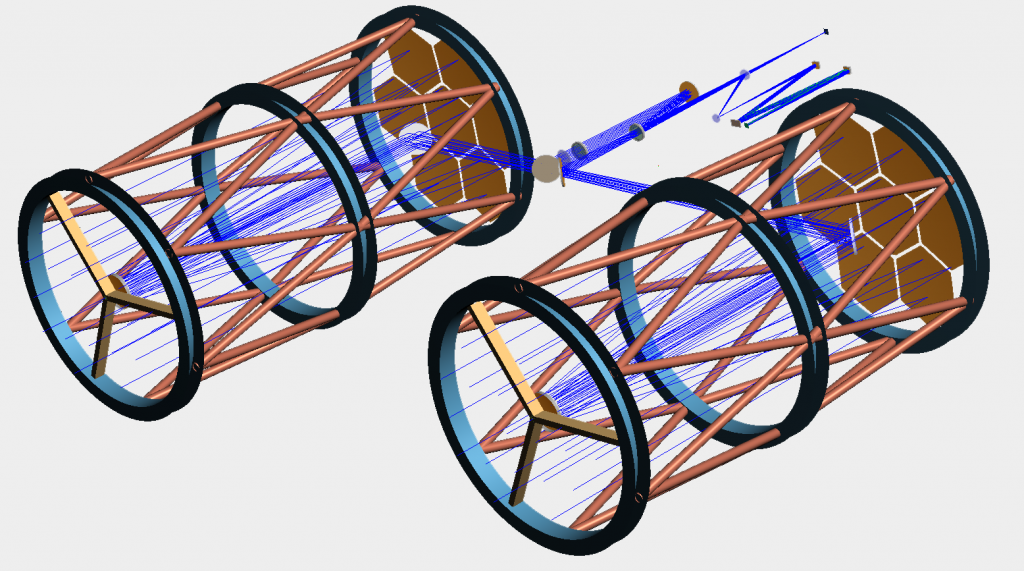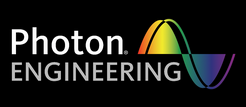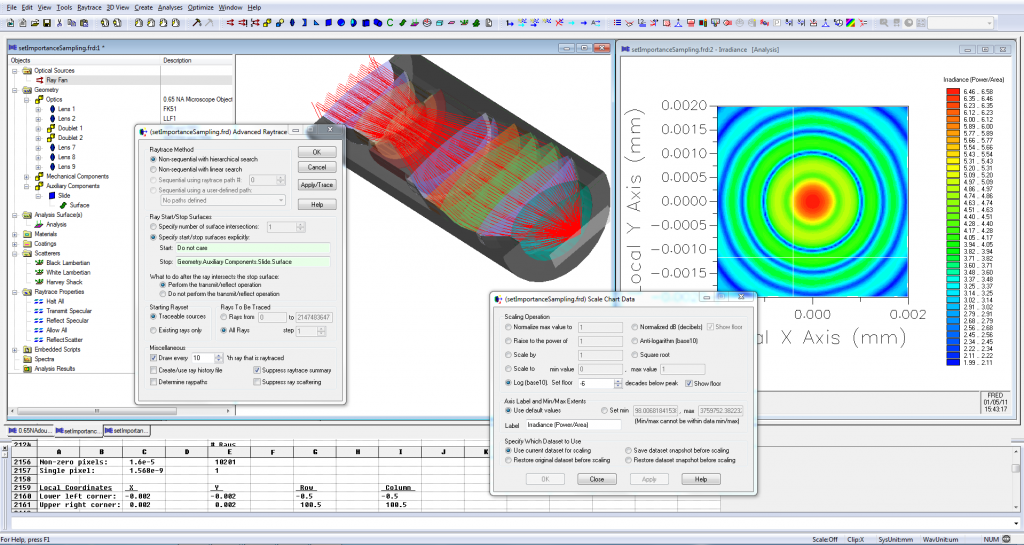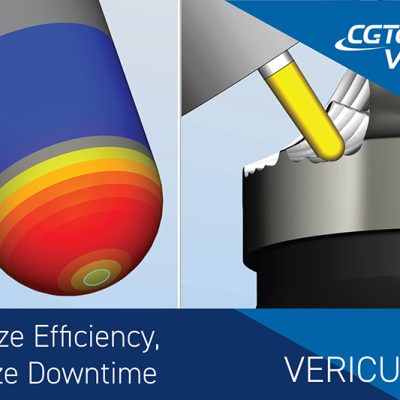Description
FREDmpc
Includes FRED and FRED Optimum features, plus:
- Up to 150x faster raytracing
- GPU-enabled massively parallel computing
- Linear scaling with number of GPUs
- Distributed computing with GPU raytracing and analyses
- 3D scene raytrace rendering

FRED Key Features
- Rapid virtual prototyping
- Real-time visualization/editing of complex optical/mechanical systems.
- Accurate simulation of virtually any light source, including include lasers, arc lamps, LED’s, ideal emitters, bulbs and user defined ray sets.
- Advanced geometry, scatter, optimization, tolerancing, scripting and graphic tools.
- No limit on surface definitions: including materials, thin film coatings, scatter models, etc.
- Cost effective package: designed specifically for engineering professionals who face real world optical problems.
Featured Applications

Coherent beam analysis
Coherent analyses in FRED showing fringe modulation (Top), white light interference (Bottom Left), laser alignment using a birefringent crystal (Bottom Center), and a telescope’s focal plane irradiance with strut diffraction (Bottom Right).
Physical Optics Modeling
FRED uses the tested and proven method of Gaussian beam decomposition for propagating coherent fields through optomechanical systems by complex raytracing. This technique allows for general modeling of coherent fields and makes it possible to simulate laser systems, interferometers, holographic systems, and even some specific applications of partial coherence.The implementation of this advanced beam propagation algorithm is largely hidden from the user, but FRED’s easy to use GUI allows optimization of the decomposition characteristics for a system through a few simple settings. At the end of the raytrace, vector and scalar field calculations can be performed at any plane in the system to establish validation and understanding of the simulation model.
For more information on coherent beam propagation in FRED, please review the Application Examples.

Stray Light Analysis
Stray light analyses with FRED showing actual and simulated images of the Apache Point 3.5m telescope (Top), ghost reflections in the MOBIE instrument of the Thirty Meter Telescope (Bottom Left), and a polychromatic ghost image in an imaging camera (Bottom Right).
Stray Light Analysis
FRED is the proven optomechanical analysis package for performing accurate stray light calculations and provides engineers with a complete toolbox of stray light utilities.
Full system specification can be accomplished by using the 13+ surface and volume scatter models, 18 material definition types (including real and imaginary refractive index values) and 7 coating types. These physical properties can be applied to any geometrical object in the model to produce realistic simulations of light interaction.
FRED’s visual interface allows instant model feedback such as scatter model parametrization verification through 2D or 3D angle and B-B0 plots and total integrated scatter (TIS) calculations. After a raytrace FRED can compile a list of scatter and ghost paths from source to a specified detector, and these paths can be re-drawn to the 3D view for visualization. Additionally, these raytrace paths can be interrogated using any of FRED’s built in or user-customized analysis routines by simple application of ray path filters.
An effective optical design and analysis program must not only have the proper tools available, the user must be able to accurately and confidently use those tools in practice. FRED’s combination of usability and accuracy make it the industry standard for stray light analysis.
For more information on stray light analysis in FRED, please review the Application Examples.

Source modeling for illumination and distribution refinement
FRED is fully capable of modeling LEDs, bulbs, and arc sources for integration with optical components and light distribution analyses.
Illumination and Non-Imaging Systems
Accurate illumination system design begins at the source, and no other optical systems design and analysis package offers more flexibility than FRED for prescribing a starting ray distribution. In addition to its default source types, users have the ability to precisely control ray positions, directions, power, wavelength, and polarization.
The built in multi-variable optimization capability allows rapid design convergence for a variety of merit functions with access to every geometrical parameter in the model.
Source power can be defined radiometric or photometric with spectra in order to perform accurate irradiance, intensity, illuminance, luminous intensity, and color image calculations, among others.
For more information on illumination applications in FRED, please review the Application Examples.

Accelerating development of biomedical systems
Modeling of biomedical systems in FRED showing volume scatter in human tissue layers (Bottom Left), fluorescence from R6G film (Left), and a human eye model using custom GRIN materials (Right).
Biomedical Systems
From non-invasive procedures to ultra-sensitive diagnostic instrumentation, photonic devices play an indispensable role in today’s bio-medical industry. For the last quarter century, timely design and delivery to market of these new technologies has been possible only with the aid of sophisticated software tools and experienced optical engineers. Photon Engineering firmly believes that its optical engineering product FRED can help accelerate the pace of innovation in the biomedical community by enabling its members to participate more fully in the process. FRED combines a GUI interface, where geometry creation and visualization are intuitive, with a powerful computational engine capable of satisfying the most demanding requirements.
Human skin models are valuable aids in the design of non-invasive diagnostic devices such as the oximeter, as well as in the development of modern dermatological instruments. FRED offers the Henyey-Greenstein volume scatter model, which is recognized by the biomedical community as being representative of scattering in human tissue. There are numerous sources for the parameters controlling the scatter model, namely an anisotropy factor g and the scattering and absorption coefficients ms and ma. A catalog of over 50 different human tissue definitions are included for the users convenience.
The physical process of fluorescence involves conversion of light at one wavelength to that of a longer wavelength. An intrinsic feature of FRED essential to modeling fluorescence is that wavelengths are assigned to rays on an individual basis. When coupled with the flexibility of FRED’s scripted scatter model feature, the path to a practical simulation of fluorescence becomes evident. Given a particular emission spectra, a scripted scatter model can be constructed that reassigns ray wavelengths by interpreting the emission curve as a probability distribution.
For more information on modeling biomedical systems in FRED, please review the Application Examples.
BASIC Scripting Language
FRED has a built-in BASIC scripting language that further extends the program’s functionality to those features which are not already provided. Basic elements such as geometry, coatings, materials, and scatter models all have user-defined script versions. With 2000+ FRED specific scripting extensions to the BASIC language, custom routines and analysis can be written to automate processes and make calculations. Additionally, the client-server automation using COM allows direct interfacing of FRED with programs such as Microsoft Excel and Matlab. The potent combination of FRED’s innovative graphical user interface and BASIC scripting language means that the capabilities of the software can be used for an extremely large variety of applications.

















Reviews
There are no reviews yet.